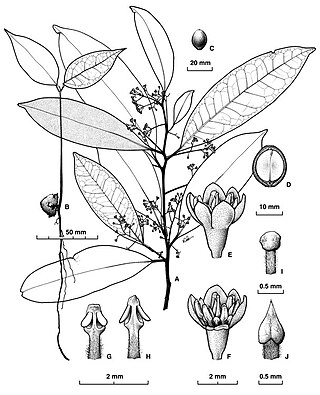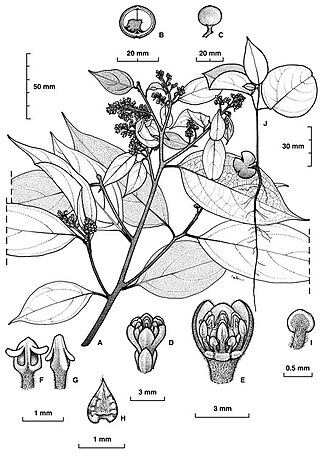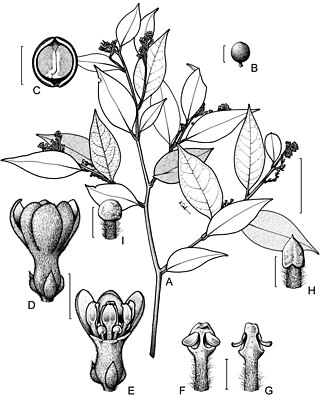
Cryptocarya foetida, commonly known as stinking cryptocarya or stinking laurel, is a species of flowering plant in the family Lauraceae and is endemic to eastern Australia. It is a small to medium-sized tree with egg-shaped to elliptic leaves, cream coloured, unpleasantly perfumed, tube-shaped flowers, and spherical black to purplish drupes.

.

Cryptocarya bidwillii, commonly known as yellow laurel, is a species of flowering plant in the laurel family and is endemic to eastern Australia. Its leaves are lance-shaped to elliptic, the flowers creamy-white and tube-shaped, and the fruit an elliptic black drupe.

Cryptocarya floydii, commonly known as Glenugie laurel or gorge laurel is a species of flowering plant in the family Lauraceae and is endemic to eastern Australia. It is a tree with lance-shaped leaves, pale green tube-shaped flowers, and spherical black drupes.

Cryptocarya corrugata, commonly known as corduroy laurel, oak walnut, acidwood or bull's breath, is a species of flowering plant in the laurel family and is endemic to north Queensland. It is a tree with egg-shaped to elliptic leaves, the flowers creamy-green, slightly perfumed and tube-shaped, and the fruit a spherical black to bluish-black drupe.

Stachystemon polyandrus is a species of flowering plant in the family Picrodendraceae and is endemic to the southwest of Western Australia. It is a diffuse to straggling, monoecious shrub with crowded, oblong, elliptic or egg-shaped leaves with the narrower end towards the base, and small yellowish-white flowers arranged singly in upper leaf axils, but forming clusters at the ends of branches.

Cryptocarya cunninghamii, commonly known as Cunningham's laurel or coconut laurel, is a species of flowering plant in the laurel family and is endemic to northern Australia. It is a tree with oblong to elliptic leaves, the flowers creamy-green and tube-shaped, and the fruit a spherical black to purplish-blackdrupe.

Cryptocarya angulata, commonly known as ivory laurel, ivory walnut, bull's breath or acidwood, is a tree in the laurel family and is endemic to north Queensland, Australia. Its leaves are lance-shaped to elliptic or egg-shaped, the flowers tube-shaped and creamy-green and the fruit a bluish or black drupe.

Cryptocarya bamagana, commonly known as Bamaga walnut, is a tree in the laurel family and is endemic to Cape York Peninsula. Its leaves are lance-shaped to elliptic or egg-shaped, the flowers cream-coloured and tube-shaped, and the fruit a spherical black drupe.

Cryptocarya bellendenkerana is a tree in the laurel family and is endemic to North Queensland. Its leaves are lance-shaped to egg-shaped, the flowers creamy-green and tube-shaped, and the fruit a spherical black drupe.

Cryptocarya brassii is a species of flowering plant in the laurel family and is native to far north Queensland and Papua New Guinea. Its leaves are elliptic to oblong or lance-shaped, the flowers cream-coloured and tube-shaped, and the fruit an elliptic black to bluish-black drupe.

Cryptocarya burckiana is a tree in the laurel family and is native to Cape York Peninsula in Queensland and to Malesia. Its leaves are lance-shaped to elliptic, the flowers cream-coloured and tube-shaped, and the fruit a spherical black drupe.

Cryptocarya clarksoniana, commonly known as Clarkson's laurel, is a tree in the laurel family and is endemic to north Queensland. Its leaves are lance-shaped to elliptic, the flowers creamy-green and tube-shaped, and the fruit a spherical black drupe.

Cryptocarya claudiana, commonly known as Claudie laurel, is a tree in the laurel family and is endemic to Cape York Peninsula in Queensland. Its leaves are oblong to elliptic, the flowers creamy-green, perfumed and tube-shaped, and the fruit an elliptic or spherical black drupe.

Cryptocarya cocosoides, commonly known as coconut laurel, is a tree in the laurel family and is endemic to north Queensland. Its leaves are lance-shaped to elliptic, the flowers creamy-green, perfumed and tube-shaped, and the fruit a spherical black to purple drupe.

Cryptocarya densiflora, commonly known as cinnamon laurel or white laurel, is a tree in the laurel family and is native to north Queensland and parts of Indonesia. Its leaves are lance-shaped to elliptic, the flowers yellowish-green and brown, tube-shaped but not perfumed, and the fruit is a flattened spherical, reddish maroon drupe that turns black when ripe.

Cryptocarya dorrigoensis, commonly known as Dorrigo laurel, is a species of flowering plant in the laurel family and is native to northern New South Wales. It is a tree with lance-shaped leaves, the flowers greenish-cream to creamy-yellow but not perfumed, and the fruit is a spherical to elliptic, black to bluish-black drupe.

Cryptocarya endiandrifolia, commonly known as narrow-leaved walnut, is a species of flowering plant in the family Lauraceae family and is native to Cape York Peninsula and New Guinea. Its leaves are elliptic to oblong or lance-shaped, the flowers cream-coloured or pale green and unpleasantly perfumed, and the fruit is a spherical to elliptic black drupe.

Cryptocarya exfoliata is a species of flowering plant in the family Lauraceae family and is native to Cape York Peninsula the Northern Territory and New Guinea. Its leaves are lance-shaped, the flowers creamy-green and slightly perfumed, and the fruit is a spherical to elliptic black drupe.

Cryptocarya grandis, commonly known as cinnamon laurel or white laurel, is a tree in the laurel family and is endemic to north Queensland. Its leaves are lance-shaped to elliptic, the flowers creamy-green, unpleasantly perfumed and tube-shaped, and the fruit a spherical drupe.





















